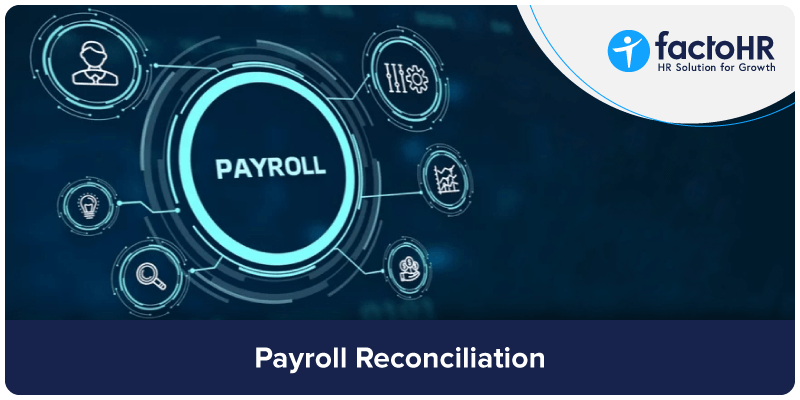Payroll Reconciliation: Process, Types & Best Practice

Table of Contents
Did you know that 68% of businesses reported at least one payroll-related error according to an American Payroll Association survey? Fair compensation has always been critical for employee engagement. Discrepancies in an organization’s payroll system can leave its employees dissatisfied.
Payroll reconciliation is an attempt to prevent such issues by double-checking the payroll records. It ensures that payments made to all employees are accurately calculated, along with relevant deductions and tax considerations. Effective payroll reconciliation eliminates the risks of underpayment or overpayment.
In this blog, we will look into the need for payroll reconciliation and the best practices organizations can implement to manage their payroll systems seamlessly.

What is Payroll Reconciliation?
Payroll reconciliation is the process of verifying employee compensation records and their accuracy. It focuses on making accurate payments to everyone in an organization. The process involves matching the employee payroll data (salary, deductions, bonuses, taxes, etc.) with the company’s financial documents. Payroll reconciliation also ensures that the deductions made in the payments are compliant with the company’s payroll policies.
Accuracy and reliability are paramount in payroll processing. Although the payroll process may seem tedious and repetitive, it’s crucial for completing payroll taxes, tracking business spending, and paying employees on schedule. As a result, careful monitoring is needed to ensure everything runs smoothly each month.
Why is Payroll Reconciliation So Important?
Payroll reconciliation is an essential means of streamlining an organization’s payroll system. It prevents payroll errors and, if detected, resolves them effectively.
Here are the key aspects of payroll reconciliation every organization should focus on:
Verification
Payroll reconciliation involves verifying every employee’s payroll data before and after processing their payment. It includes practices like tallying working hours with timesheets, confirming bonuses and payroll deductions, checking salary calculations, and more.
Accuracy
Payroll reconciliation ensures that every employee receives a salary calculated as per the company’s payroll policies. It ensures that details like gross pay, net pay, and deductions are reflected accurately in the payroll system.
Error Detection
Payroll reconciliation identifies such errors and rectifies them. An effective procedure detects errors like duplicate records, unusually high or low payments, missing records, incorrect tax deductions, and more.
Compliance
Every organization needs to comply with local, national, and industry-specific regulations while managing payroll. Payroll reconciliation ensures that all payments are made according to these regulations. It also ensures that an organization is up to date with the latest tax laws and Government regulations.
Financial Reporting
If a company’s payroll figures are incorrect, the financial records will reflect the same errors. Payroll reconciliation ensures that the payroll entries are accurately reflected in a company’s accounting software. This leads to precise internal and external financial reporting.
Regular Schedule
Salary reconciliation is an ongoing process. Organizations can choose to conduct it monthly or quarterly. HR managers can prepare a fixed schedule for reconciliation depending on their requirements and preferences. In most cases, it is either before a payroll cycle or at the end of every month.

What is the Payroll Reconciliation Process?
The specific payroll reconciliation process may slightly differ from one organization to another. Here are the basic steps involved in every procedure:
1. Verifying the Payroll Register
Every organization has a detailed record of payment information for a specific period. This record is called a payroll register. The payroll reconciliation process starts with verifying these records, ensuring that the payments of all employees are accurately listed.
2. Verifying Attendance Information
Unpaid leaves lead to a salary deduction. Employee attendance is matched with the payroll data to ensure accurate salary calculation.
3. Checking Pay Rates
The pay rates of employees are matched with the organization’s HR policies and contracts. At this stage, details like bonuses, payroll deductions, and overtime are also verified.
4. Observing Tax Deductions
Before submitting payroll, every employee’s tax deductions are calculated and verified according to the applicable standards and regulations.
5. Submitting Payroll
Once all details are verified and approved, the payroll is submitted to the organization’s payroll system. Payments are then made as scheduled.
6. Keeping Books Up-To-Date
Organizations maintain a detailed record of all payroll transactions for accurate financial reporting and auditing. These records also help HR managers identify and fix any issues in the payroll reconciliation procedure (if any).

Understanding the Types of Payment Reconciliation
An organization conducts payment reconciliation procedures depending on the type of data involved. Here are some of the most common payment reconciliation types:
Bank Reconciliation
Bank reconciliation involves matching a company’s cash account with its bank statement. The two should match to ensure accurate payment of salaries. Any discrepancy here will show inaccurate payroll management.
Credit Card Reconciliation
This procedure is similar to bank reconciliation, the only difference being the reference point. It involves matching a company’s cash account with the credit card statements to ensure accuracy in payroll management. Such reconciliation also helps managers detect fraudulent or unauthorized transactions.
Accounts Receivable Reconciliation
Accounts receivable reconciliation involves matching the payments a company receives with the invoices it generates. It checks whether the organization has successfully received the payments owed by its debtors. It also identifies and fixes issues like underpayments and overpayments.
Accounts Payable Reconciliation
In this process, an organization matches the payments it made with the invoices it received. It checks if the company has made timely payments and is on track in terms of the payments to be made (especially to suppliers).
Intercompany Reconciliation
Such reconciliation is applicable for multiple branches operating under a single umbrella. It matches the transactions taking place between subsidiaries or divisions of the same organization. This ensures consistency of financial records across the board.
Payroll Reconciliation
Payroll reconciliation ensures that the employees in an organization receive fair and timely salaries. It ensures that precise deductions are made and bonuses added according to specific company policies. Such reconciliation also ensures that a company follows the applicable Government and legal regulations while paying salaries to its employees.
General Ledger Reconciliation
This procedure takes the bigger picture into consideration. It involves matching the transactions recorded in the general ledger with smaller records or documents.
Suppose a company’s Salaries Expense account in the general ledger shows a balance of ₹10,00,000. The company would reconcile it by matching it with individual payroll records and its bank statements for the concerned time period.

Best Practices for Reconciling Payroll Accurately
Setting right any errors made without reconciliation is well worth the effort, despite the reconciliation procedure being somewhat drawn out. Here are a few pointers to make sure the procedure goes smoothly:
Well-Coached Payroll Staff
An organisation must ensure that payroll staff are adequately coached. In order to guarantee that all financials are accurately accounted for, a check-and-balance mechanism should also be in place.
Employee Classification
Companies should focus on proper employee classification to process payments for different categories based on salaries, working hours, taxes, etc.
Year-End Reconciliation
Organizations should have a year-end payroll assessment plan. This will make the implementation process more precise and effective the following year.
Deciding KPIs
KPIs like total reconciliation time, mistakes deducted, time taken to fix mistakes, etc., make process monitoring and reconciliation assessment easier.
Payroll Automation
Automating the payroll process significantly reduces the risk of human error and increases operational efficiency. With the right software in place, repetitive and time-consuming tasks such as tax calculations, deductions, and payslip generation can be handled seamlessly.
Reconciling before Payments
Organisations usually carry out reconciliation after employee payments have been made. However, the ideal time to complete it is a few days before payday to save time and effort.
Payroll Reconcliation Checklist
Creating such a checklist will act as a ready reckoner throughout the reconciliation process and also serve as part of a checklist for educating payroll personnel.

Conclusion
Payroll reconciliation helps organizations ensure that they make accurate and verified payments. It helps them comply with their HR policies and applicable government regulations. Following a systematic reconciliation process and checklist makes salary calculation accurate. In the digital age, modern payroll software solutions help organizations reconcile their payroll with a few simple clicks.
factoHR is one such payroll software that provides HR managers a single and secure platform for all their payroll data. The cloud-based solution ensures accurate payroll calculation and compliance. Features like built-in compliance management, attendance reconciliation, salary revisions, and more help organizations make verified and timely payments to every employee.
Grow your business with factoHR today
Focus on the significant decision-making tasks, transfer all your common repetitive HR tasks to factoHR and see the things falling into their place.

© 2025 Copyright factoHR


